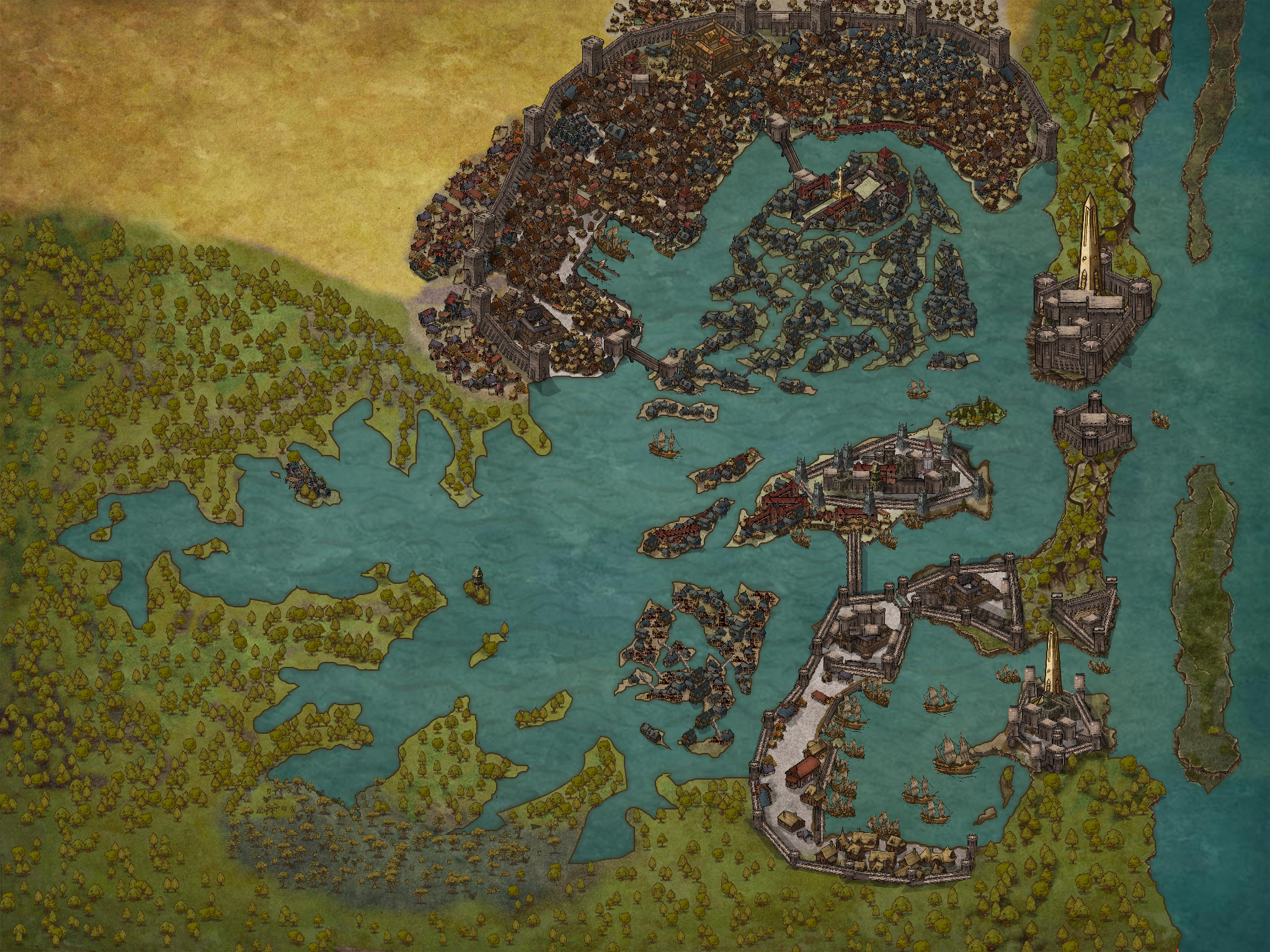The Constabuli
Constabuli-Teri (land constables)
Constabuli-Aqui (water constables)
Background
The Constabuli is the law enforcement agency of Fariosi city proper. The Constabuli operates under the auspices of Justice and falls into two broad categories, the Constabuli-Teri which patrols the land bound portions of the city and the Constabuli-Aqui which patrols Banyugar-Fariosi (Water-Town Fariosi). The Constabuli is organized by ‘Watches’ for each of the city’s districts. Each district has a certain number of watches, depending upon its size and population.
(For example: Merchant’s Ward: 1st or 2nd Watch, -Teri or -Aqui. Visitor’s District: 1st or 2nd Watch -A,-B, or -C, -Teri or -Aqui.).
The Constabuli is funded by the Ministry of Justice, though the pay level is traditionally quite low, making it difficult for watch captains to recruit and retain quality constables. Likewise, there are problems with endemic corruption due to the manner in which the Constabuli tries and fines low level criminality.
Forfeiture Policy
When Constables apprehend the perpetrator of a minor offense such as pickpocketing, operating a business without a license, public indecency, public nuisance, property damage/vandalism, they will fine the offender for the ‘appropriate’ amount as mandated by the Ministry of Justice . When an offender does not have hard coin, however, the constable is empowered to confiscate personal belongings within the perpetrator’s possession that are “deemed appropriate and commiserate with the legally listed fine”. This controversial policy is touted for saving the city the time and expense of having to detain offenders for fines or trial for relatively minor crimes. Likewise, it frees the courts for more serious crimes such as rape, murder, etc. Critics of the policy complain that it “promotes corruption and abuse by poorly trained and unsupervised constables”. To be fair, many of these criticisms may be valid. New constables are taught to judge the value of a fine for various offenses by their more experienced training constables. The amount of oversight for this training process or how the actual forfeitures are carried out are determined by watch sergeants and the watch captain. Unfortunately, there appears to be little or no regular oversight beyond the aforementioned watch captain.
Added to this is the “Watch Operational Percentage”. Fines and forfeitures seized by the constables are turned in at the watch house to the Evidence Attendant, a constable charged with the appraisal of incoming forfeitures, cataloging and tallying of the values of incoming fines and forfeitures, forwarding the appropriate percentage for that ward (Slums: 60%, Merchant Ward: 70%, Visitor’s Isle: 80%, etc) to the city government to be divided among the appropriate bureaucratic branches (Ministry of Justice, ministry of Public Works, etc) and distribute percentages of the remainder to that Constabuli Watch (70% Watch ward, 10% Watch Captain, 5% Watch Sergeant, 5% Evidence Attendant, 10% Arresting Constable). Critics decry this system, pointing out that there is an innate conflict of interest when the constable gets a percentage of the value of their fines and forfeitures. Proponents point out that the actual percentage ranges from a low of 1% of the total fine value in the Dominion Isle Watch to 4% for the Slums Watch. They state that this compensation helps to make up for the abysmal pay that most constables receive. Likewise, they argue that this compensation scheme helps deter cash-strapped and demoralized constables from more overt corruption such as demanding bribes and shaking down citizens for money. Opponents naturally argue that this argument is delusional and that a corrupt constable will both take their percentage AND demand bribes and shake-downs.
Admittedly, the Constabuli has a sordid history of endemic corruption, often with the knowledge and protection of a corrupt Watch Captain. Inquisitors of the Ministry of Justice do their best to stamp out such activity but have learned the harsh, real-world lesson that some petty corruption is unavoidable and must be tolerated in order to keep the Constabuli functional at all. In extreme cases, entire watches have had to be fired or jailed when their criminality becomes extreme.
Profile of the Constable
Detractors claim that the Constabuli is filled with lazy ne’er-do-wells too lazy to do hard, honest labor or bullies who seek a legal means to inflict cruelty to others. Supporters point to the unquestionable valor of the constables in bravely charging into danger in order to protect their fellow Fariosi. Given how poorly the Constabuli pays their ranks, these advocates hold up the constables as brave and self-sacrificing, accepting dangers for little pay and even less recognition.
As with many societies, the Constabuli of Fariosi is often made up of newer immigrant populations who are seeking a livelihood in a generally unaccepting society. The make-up of different watches is effected by the make-up of the local community in which the watch operates. The Dominion Isle, for example, has a disproportionately high number of ethnic Lutipri, while Trader’s and Visitor’s Isles have a far more eclectic make-up. The watches of Old Fariosi have many of the more ‘undesirable’ races such as half-orcs, Valladi, and Om-Valladi catfolk, half-elves, and others. 
Comments